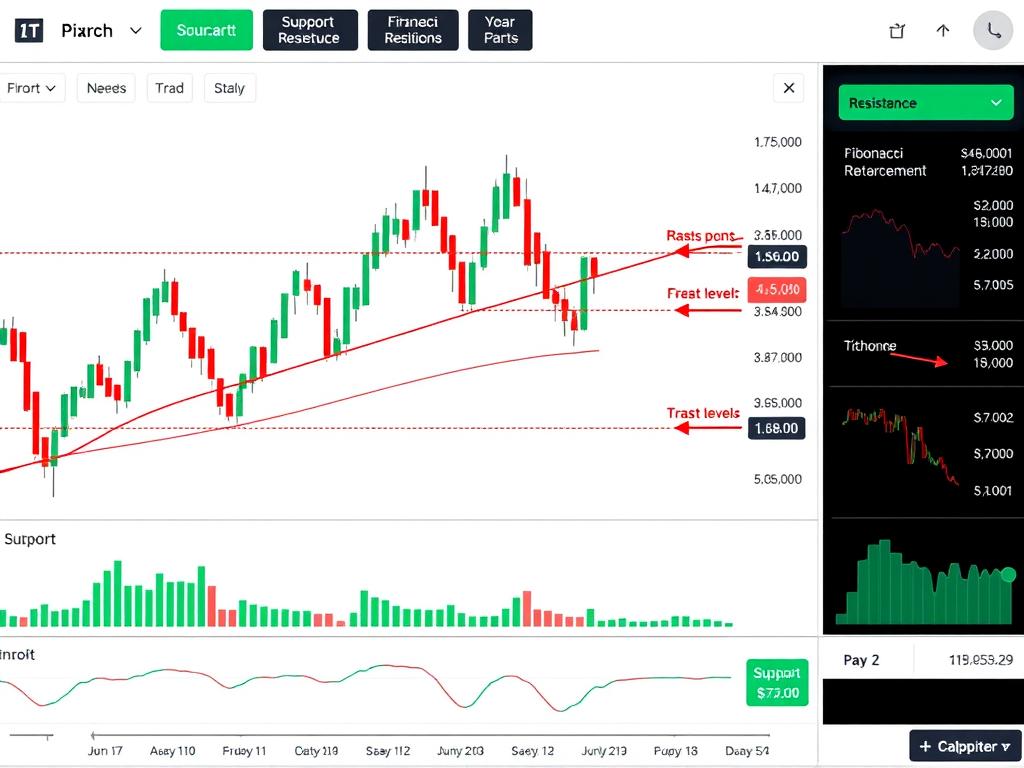
Mastering Key Market Levels: A Comprehensive Guide to Trading Support, Resistance, and Beyond
Share
Mastering Key Market Levels: A Comprehensive Guide to Trading Support, Resistance, and Beyond
Understanding key market levels is one of the most critical skills any trader can develop. Whether you're a seasoned veteran or just starting out, identifying and trading these levels effectively can significantly enhance your strategy and profitability. In this comprehensive guide, we'll delve into the world of market levels, exploring what they are, how to identify them, and how to integrate them into your trading plan.
What Are Market Levels?
Market levels refer to specific price points on a chart where significant buying or selling activity has historically occurred. These levels can act as barriers that prevent the price from moving further in a particular direction (resistance) or as floors that support the price (support). Identifying these levels is crucial because they often indicate where price action may pause, reverse, or accelerate.
Types of Market Levels
There are several types of market levels that traders should be aware of:
1. Support Levels
Support levels are areas where buying interest is strong enough to prevent the price from falling further. These levels are often associated with increased demand, as traders and investors see value at these prices and are willing to buy. Support levels can be identified by looking for areas where the price has bounced back multiple times.
2. Resistance Levels
Resistance levels are the opposite of support levels. These are areas where selling pressure is strong enough to prevent the price from rising further. Resistance levels are often associated with increased supply, as traders and investors are willing to sell at these prices. They can be identified by looking for areas where the price has struggled to break above multiple times.
3. Pivot Levels
Pivot levels are calculated points that traders use to determine potential areas of support and resistance. They are typically based on the previous day's high, low, and closing prices. Pivot levels can be particularly useful for day traders who are looking to capitalize on short-term price movements.
4. Fibonacci Levels
Fibonacci levels are based on the Fibonacci sequence and are used to identify potential areas of support and resistance. These levels are calculated by identifying significant high and low points on a chart and then drawing lines at specific percentages of the distance between these points. Fibonacci levels are widely used in technical analysis and can be particularly useful for identifying potential turning points in the market.
How to Identify Market Levels
Identifying market levels requires a combination of technical analysis skills and practice. Here are some steps you can follow to identify market levels effectively:
1. Look for Historical Price Action
One of the best ways to identify market levels is by looking at historical price action. By examining where the price has bounced back or struggled in the past, you can identify potential areas of support and resistance. These areas are often revisited in the future, making them key levels to watch.
2. Use Technical Indicators
There are a number of technical indicators that can help you identify market levels. For example, the Value Markers Indicator can help you identify areas of high trading activity, which often coincide with key support and resistance levels. Similarly, the Wick Test Indicator can help you identify areas where there has been significant buying or selling pressure.
3. Draw Horizontal Lines
Drawing horizontal lines at key levels can help you visualize areas of support and resistance. These lines should be drawn at areas where the price has bounced back or struggled multiple times. The more times the price has interacted with a level, the more significant it becomes.
4. Look for Confluence
Confluence occurs when multiple factors line up at the same level. For example, a Fibonacci level, a pivot level, and a previous support or resistance level all aligning at the same price point creates a high-probability area where the price is likely to react. Looking for confluence can help you identify the most significant market levels.
How to Trade Market Levels
Once you've identified key market levels, the next step is to learn how to trade them effectively. Here are some strategies you can use:
1. Bouncing Off Support/Resistance
One of the most common ways to trade market levels is to look for the price to bounce off a support or resistance level. For example, if the price is approaching a well-defined support level, you could look to enter a long position as the price bounces off this level. Conversely, if the price is approaching a resistance level, you could look to enter a short position as the price struggles to break above it.
2. Breaking Out of Levels
Another strategy is to look for breakouts above or below key market levels. If the price breaks above a resistance level, it could signal the start of a new uptrend. Similarly, if the price breaks below a support level, it could signal the start of a new downtrend. These breakouts can be particularly powerful trading opportunities, as they often lead to significant price movements.
3. Using Levels as Targets
Key market levels can also be used as targets for your trades. For example, if you're in a long position, you could set your profit target at a resistance level above your entry point. Conversely, if you're in a short position, you could set your profit target at a support level below your entry point. This helps you maximize your profits while minimizing your risk.
4. Combining with Other Indicators
Finally, combining market levels with other technical indicators can help you create a more robust trading strategy. For example, you could use the Higher Timeframe Candles Indicator to identify the overall trend and then use market levels to find entry and exit points within that trend. Similarly, you could use the Pace of Tape Indicator to gauge market momentum and confirm whether a breakout is likely to hold.
Conclusion
Mastering key market levels is a skill that takes time and practice to develop, but it is one of the most valuable tools you can have in your trading arsenal. By understanding how to identify and trade these levels, you can make more informed decisions, reduce your risk, and increase your chances of success in the markets. Whether you're trading stocks, forex, or cryptocurrencies, the principles of market levels remain the same, making this a versatile skill that can be applied across all types of trading.
Remember, the key to success lies in consistency and discipline. By sticking to your strategy and continually refining your skills, you can become a master of key market levels and take your trading to the next level.
